
In the pursuit of energy efficiency and cost reduction, businesses are turning to innovative solutions like commercial tinting. This article explores how commercial window tinting can be a cost-effective approach to reducing energy bills and enhancing the overall efficiency of business operations.
Understanding the Energy-Saving Benefits of Commercial Tinting
Reduction in Cooling Costs
Commercial window tints can block a significant portion of solar heat from entering a building, thereby reducing the need for air conditioning. This can lead to substantial savings in energy costs, especially in regions with high temperatures and strong sunlight.
Consistent Indoor Temperatures
By minimizing the heat gain through windows, tinting helps maintain consistent indoor temperatures, reducing the strain on HVAC systems and contributing to overall energy efficiency.
Long-Term Financial Benefits of Tinting
ROI of Commercial Tinting Investments
While the initial investment in window tinting might seem substantial, the long-term savings in energy costs provide a significant return on investment (ROI), often within a few years of installation.
Extended Lifespan of HVAC Systems
By reducing the load on air conditioning systems, window tints can extend the lifespan of these costly systems, leading to additional long-term savings.
Additional Advantages of Commercial Window Tinting
Enhanced Comfort and Productivity
Apart from energy savings, tinted windows can create a more comfortable working environment by reducing glare and hotspots, potentially leading to increased employee productivity.
Protection Against UV Radiation
Commercial tints block harmful UV rays, protecting both employees and office furnishings from UV-related damage and health risks.
Commercial tinting is more than just an aesthetic choice; it’s a cost-effective strategy for energy savings. By investing in commercial window tinting, businesses not only reduce their energy costs but also contribute to a more sustainable, efficient, and comfortable work environment.